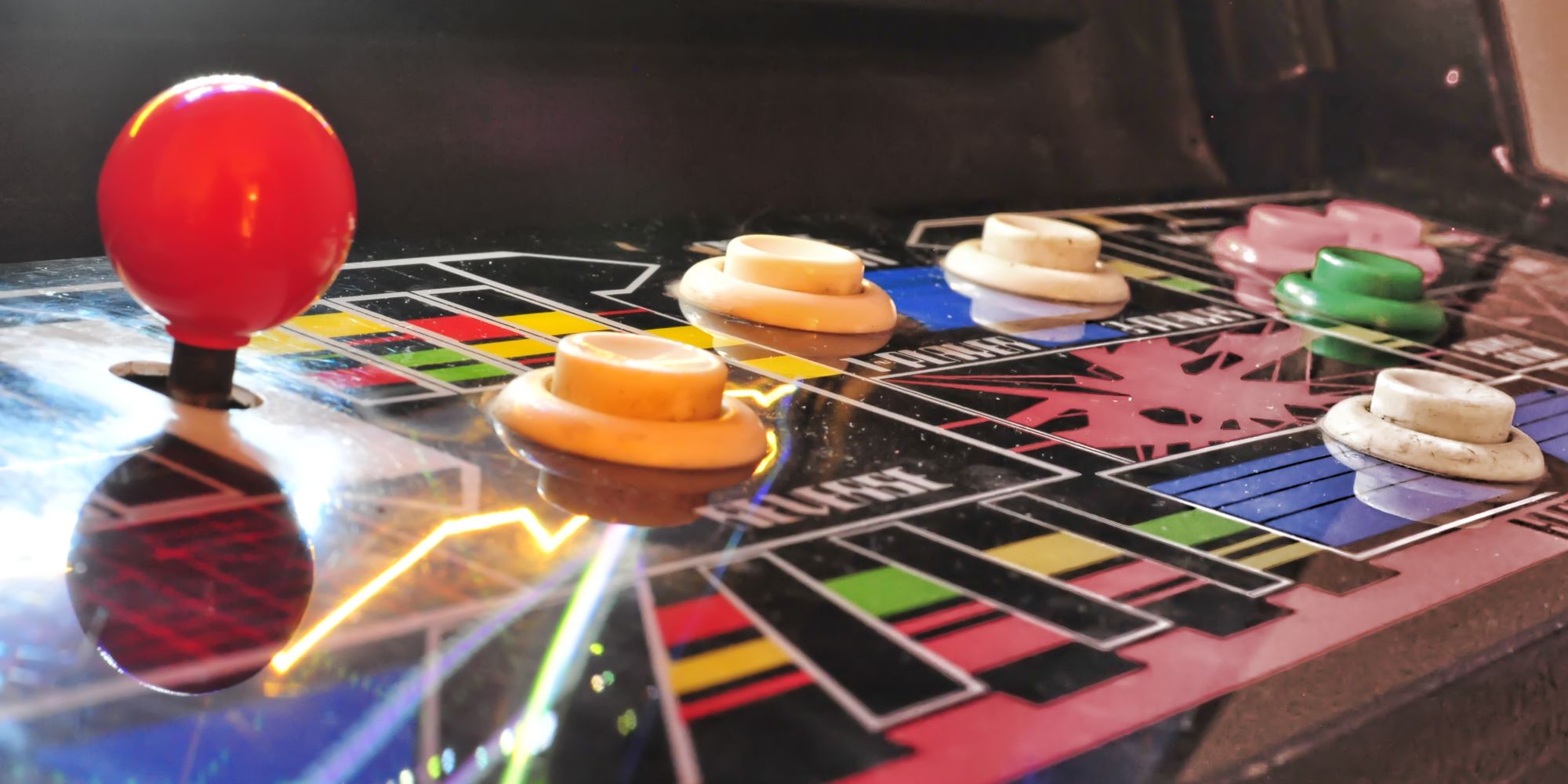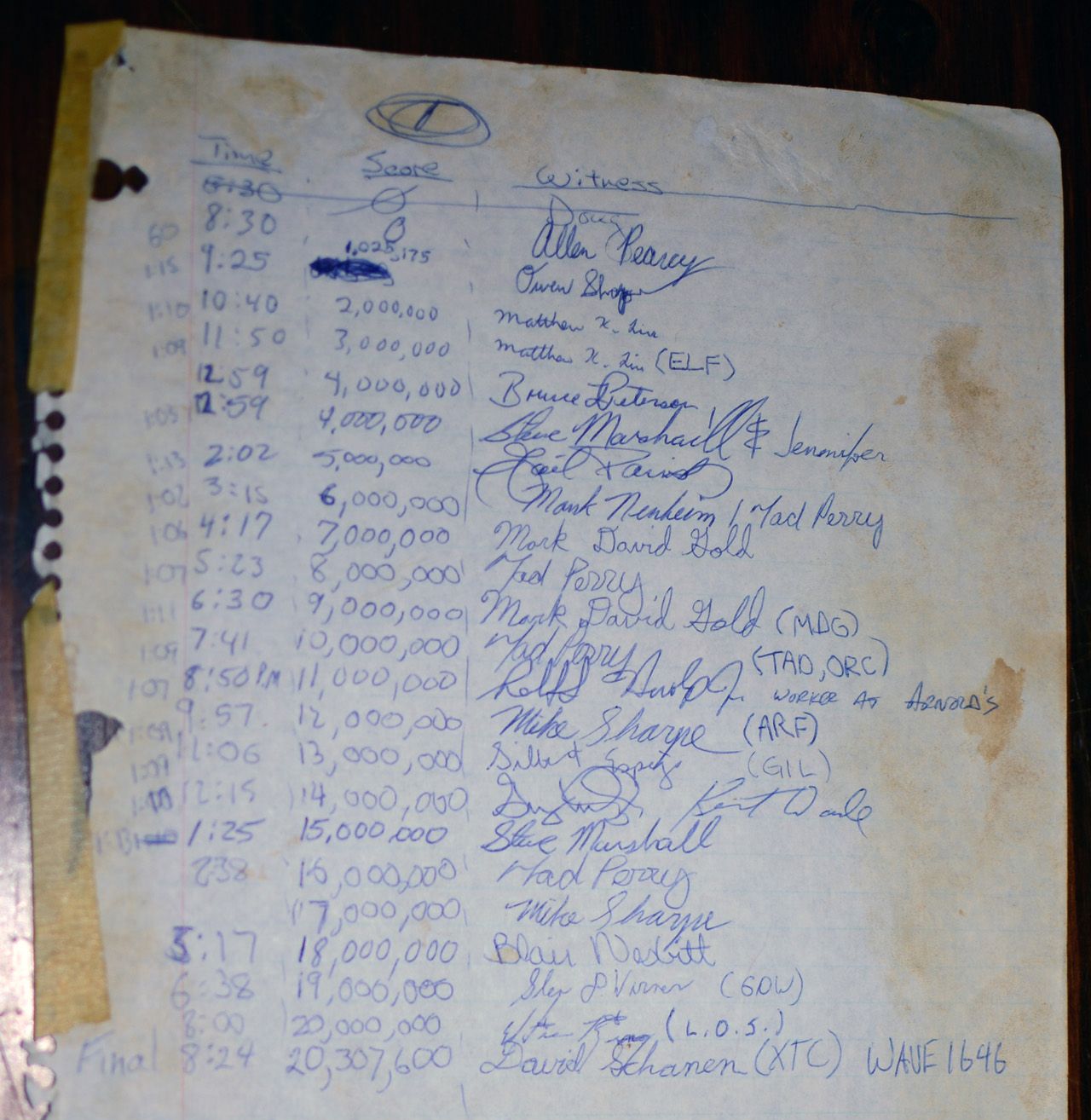Defender, Chapter 11: Miscellaneous

This chapter is a collection of little tricks, advanced ideas, and fun things to do with the game of Defender. The reason I included these items was not necessarily to help your score, since most of them are of questionable value there, but to give you an insight into the kinds of things you might want to include in your own personal style. Style is a meaningless word for most video games (since there is only one right way to do things), but it definitely applies to Defender playing. The best approach for one Defender player may be a complicated disaster in the hands of another, so each player must develop his own unique style of play.
In Seattle, where I play, the top players are very aware of the idea of style in Defender playing. Some players even refer to particular styles of play by the part of town where they originated. East Side players (from Bellevue and Kirkland) have the most compassion for the men on the planet’s surface; they never shoot them intentionally, and catch almost every man that goes up. South End players (from Renton, Kent, and Des Moines) like to shoot baiters – they’ll often wait for a few at the end of a wave. North End players (from Wallingford, Lake City, and the University District) are careful and consistent and they play to win.
Counting waves by color
If you watch the border that separates the main screen and radar screen, you’ll notice that it changes color on each wave. Furthermore, the color of the border changes in a predefined order: the first wave is always blue, and the borders cycle through the colors blue, green, red, orange, yellow, purple, brown, and black. (The black border looks like no border at all, since the background screen is black.)
By checking the color of the border, then, you can figure out which wave you’re on. For waves higher than 8, you must add eight (or a multiple of eight) to the number you get. For example, suppose you’re near the end of an attack wave and your last man is going up. You aren’t sure whether it’s worth intentionally getting blown up to save him, since you’ve forgotten which wave you’re on. You notice that the border is blue, and your score is 110,000. Well, blue is the first color, but you know by your score that you’re well past the first attack wave. So add eight to the first attack wave and you get nine, the correct wave number. Since you’re going to get 10 more men on wave 10, you can ignore that last man’s predicament.
Of course, the first few times you use the colors in this situation you may find yourself ignoring him whether you want to or not (because by the time you figure out which wave you’re on, the man will have already mutated). After a while, though, watching the border colors will be as automatic as shooting mutants.
Intentional free space
If you know that you’re going to get more men on the next wave, going into free space can be helpful. This usually happens when you have many baiters on the screen and only one or two opponents left in the wave. If your last man is nearby, just shoot him. The baiters will all be repositioned, and you might end up in a better position to finish off the wave. It’s like hyperspacing, but you always survive. Watch the radar closely so you’ll know where your opponents are hypered to.
If you’re carrying your last man on the last wave in a block, don’t set him down until you’re about to shoot the last opponent in the wave. If a baiter appears before then, you’ll be carrying an instant baiter repellant; set the man down while firing and coasting backwards, and the baiter will back off for a while.
The first wave game
Many players like to see how many points they can score during the first attack wave. Normally the first wave is worth 3250 points, but it’s possible to get well over 20,000 points by picking up and setting down men and shooting baiters.
There are 15 landers in the first wave, so the most extra points you can get from catching and setting down men is 14,000. (Unless you catch a man after shooting the last lander – see below.) This makes 17,250 points possible. If you hang around and shoot baiters, you can add to this score, but the last lander will probably pick up a man while you do. That costs you 100 points (the lost bonus for one man). After the last lander has mutated, you can play the mutant reverse line and shoot baiters all day (or until your ships run out). Or, if you see a lookout during the wave, leave that lander for last. He won’t move or pick up a man, so you save the 100 point bonus.
Another fun thing to do on the first wave is to catch all 10 men at once. Then, if you set them down at high speed, the men (and corresponding 500 point bonus signs) will be strewn over a long stretch of the terrain. If you set them down in a low spot in the terrain, you can push some of the men right through the ceiling – they will end up at the top of the screen, hanging in mid-air. This is how you “hang ten” in Defender. When a lander comes along, he won’t be confused, though. He’ll go straight up to the man he wants.
A few paragraphs back, I said that you can’t catch a man being carried away by the last lander. Well, that isn’t quite true. You can catch the last man, and add 500 points to your total first wave score, but it requires careful timing and a little luck. The way to catch him is to fly straight at the lander and fire just as you’re about to hit it. Then, if you pull down quickly, you may catch the falling man before the machine realizes that the wave is over. Or, you can shoot the last lander just as he’s starting to pick up a man. Then the machine will give a 250 point bonus for the man falling safely back to the planet before the wave is over. You can get the 250 point bonus any time after the lander grabs hold of the man, even if they haven’t left the surface yet.
Making it hard on yourself
Some players, usually good ones, like to make the game of Defender a little harder by playing in free space or playing without smart bombs. Playing without smart bombs is particularly good practice, since it forces you to adhere to the priorities listed in Chapter 10. Although some players claim that shooting all of your men at the start of the game is good free space practice, this is questionable. The first four waves are so easy in space (compared to higher waves) that it might actually hurt your free space game. But it’s fun to do and a great way to show off.
A good way to make the game harder on yourself is to find a Defender machine that has been set faster than normal. The game of Defender can be set to play so fast that it will be a challenge to even the best of players. Fast machines will pick up your men more quickly, so playing with the advanced strategy of Chapter 10 is almost a requirement. Also, baiters will appear very often, even early in the attack wave. And free space on fast machines can be an uncontrolled disaster, even in the hands of otherwise good free space players.
If you get a chance to change the settings on the Defender machine you play, you’ll notice that there are two game-difficulty settings – settings 18 and 19. The first one defines how hard the game starts out (attack wave 1), and the second setting defines how many waves the game continues to get harder before the difficulty levels off. These two settings can be adjusted from 0 to 99; the normal factory settings are 5 for the first setting and either 10 or 15 for the second setting, depending on whether it is a new machine or old machine. (You can tell new machines from old machines by the quarter slot – old machines have a metal slot, and new machines have a plastic one.) One good setting is 5 for the first one and 99 for the second. This makes the game exactly like normal for the first 15 waves. Then, instead of staying at the difficulty of wave 15 (as with the normal settings), the game continues to get progressively harder.
Another setting that can be changed is the number of points required for another ship and smart bomb. This is usually set to 10,000 points, and a small change can make a big difference in your strategy. For example, if this setting is changed to 12,000 points, you won’t always earn another smart bomb for finishing a wave of free space. If the setting is changed to 15,000 points, finishing an attack wave with the advanced strategy (which yields 13,000 to 14,000 points) won’t earn an extra smart bomb, and you’ll run out of smart bombs quickly even if you just use them for the pods at the beginning of the wave.
Getting the high score: 999,975
Once you are able to break 1,000,000 points, as any player that studies and practices the concepts in this book will eventually be able to do, you’ll probably want to register the highest score the Defender machine will display: 999,975 points. Any higher score than that, and the score goes back to zero and starts over. It’s not easy to stop at exactly 999,975, however, because you’re getting an extra ship for everything you hit at that point in the game. (See “Marathon Playing” later in this chapter.) The only way to get rid of these turns, without earning even more, is to hyperspace until your last ship blows up.
The best way to get to 999,975 is to cross 990,000 with just one or two ships, and then run into things to get to 999,975. That way you’ll only have one or two ships to hyperspace away at 999,975. You want to have as few ships as possible there, because there is a chance each time you hyperspace that you’ll land on something when you reappear (something that could push you over 1,000,000 and back to zero).

Not catching the last man
There is a situation where you can neglect to catch your last man, and still not go into free space; destroy everything that’s left in the attack wave before your last man hits the ground, and he will survive. The only time this is useful is when you only have a few opponents left, they’re all on the screen, your last man is going up, and a baiter prevents you from catching him. You needn’t die in this situation. Just shoot the lander carrying the man, and try to shoot everything else in the wave before the man hits the ground. If you’re running out of time, use a smart bomb.
Marathon playing
Once you have reached 1,000,000 points, you’ll probably decide to go out and set some kind of record: personal record, world record, highest score ever at Joe’s Texaco – that kind of thing. When you do, there are a few things you should know.

First and most obvious is that whenever your score is between 990,000 and 1,000,000 you’ll be getting an extra ship and an extra bomb for everything you hit. These extra ships are not really extras, though. You’re just getting an advance on unearned ships; you won’t get any ships at all for a while after you reach 1,000,000 and roll the score over (back to zero), and it all evens out in the end – if you earned 50 extra ships between 990,000 and 1,000,000, you won’t get an extra ship or smart bomb the next 50 times you should have (not until 1,500,000 points).
There is a trick that lets you keep on getting ships are the machine rolls over, but it takes a little time to do. The object is to earn exactly 101 extra ships between 990,000 and 1,000,000. When you do this, the machine will try to give you a dry spell of 1,010,000 points without an extra ship. But since the machine can’t count past 1,000,000, the dry spell is only 10,000 points long, and you start getting ships again at 10,000 points beyond the first 1,000,000.
In order to earn exactly 101 extra ships in 10,000 points, you’ll have to run into quite a few bullets (25 points each). Although those extra ships will be lost because you ran into a bullet to get each one, you get to keep the extra bombs. This means that you will cross 1,000,000 points with over 100 smart bombs built up. Play accordingly.
At some point in your marathon, you’ll probably want to take a break. If there’s nobody around to take over while you’re gone, you’ll just have to let a few of your surplus ships blow up while you’re away. The best time to do this is after 256 attack waves; every 256 attack waves, the game starts over, and you won’t lose as many ships on the slower early waves while you’re away from the controls.
If you want to score as many points per hour as possible, find a game that has the game adjustments both set to 1 (or set them yourself, if you have access to the settings). This will prevent the landers from firing as often and all but eliminate baiters. As a result of this, you’ll be able to fly faster and shoot more landers without getting shot yourself, and you’ll never waste valuable seconds sparring with baiters. On the factory settings 800,000 points per hour is a typical rate, but over 1,000,000 points per hour is possible when the machine is set very easy.
The last two paragraphs bring up an important point about the validity of video game marathon records, particularly on adjustable games like Defender. Since the machine’s settings can be changed to radically alter the game, or players can alternate turns while taking breaks, Defender-playing marathon records can’t be used to determine the relative ability of Defender players. Only head-to-head competition on the same machine at the same time (preferably a machine set more difficult than normal) can determine which is the better of two Defender players. And unless some type of national (or international) competition is organized, the question of who is the best player will be unanswered. That the Defender world record has changed hands as many as three times in a week is a sign of its insignificance. (If you’re interested, the current world record was around 30,000,000 at the time of this writing – 4:15pm PST, March 18, 1982.)
- About this book
- Introduction
- Chapter 1: Getting Started
- Chapter 2: The Controls
- Chapter 3: Landers
- Chapter 4: Mutants
- Chapter 5: Swarmers
- Chapter 6: Bombers
- Chapter 7: Baiters
- Chapter 8: Catching Humanoids
- Chapter 9: Free Space
- Chapter 10: Strategy
- Chapter 11: Miscellaneous
- Chapter 12: Stargate
- Chapter 13: Attitude
- Acknowledgments